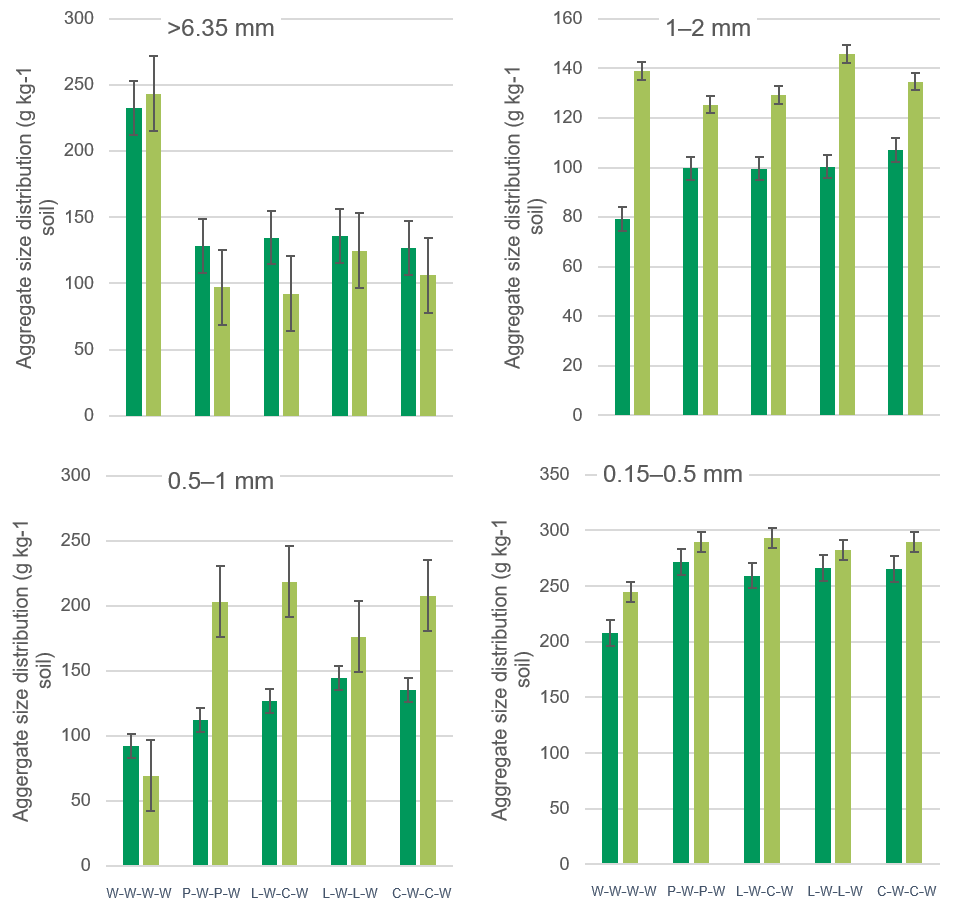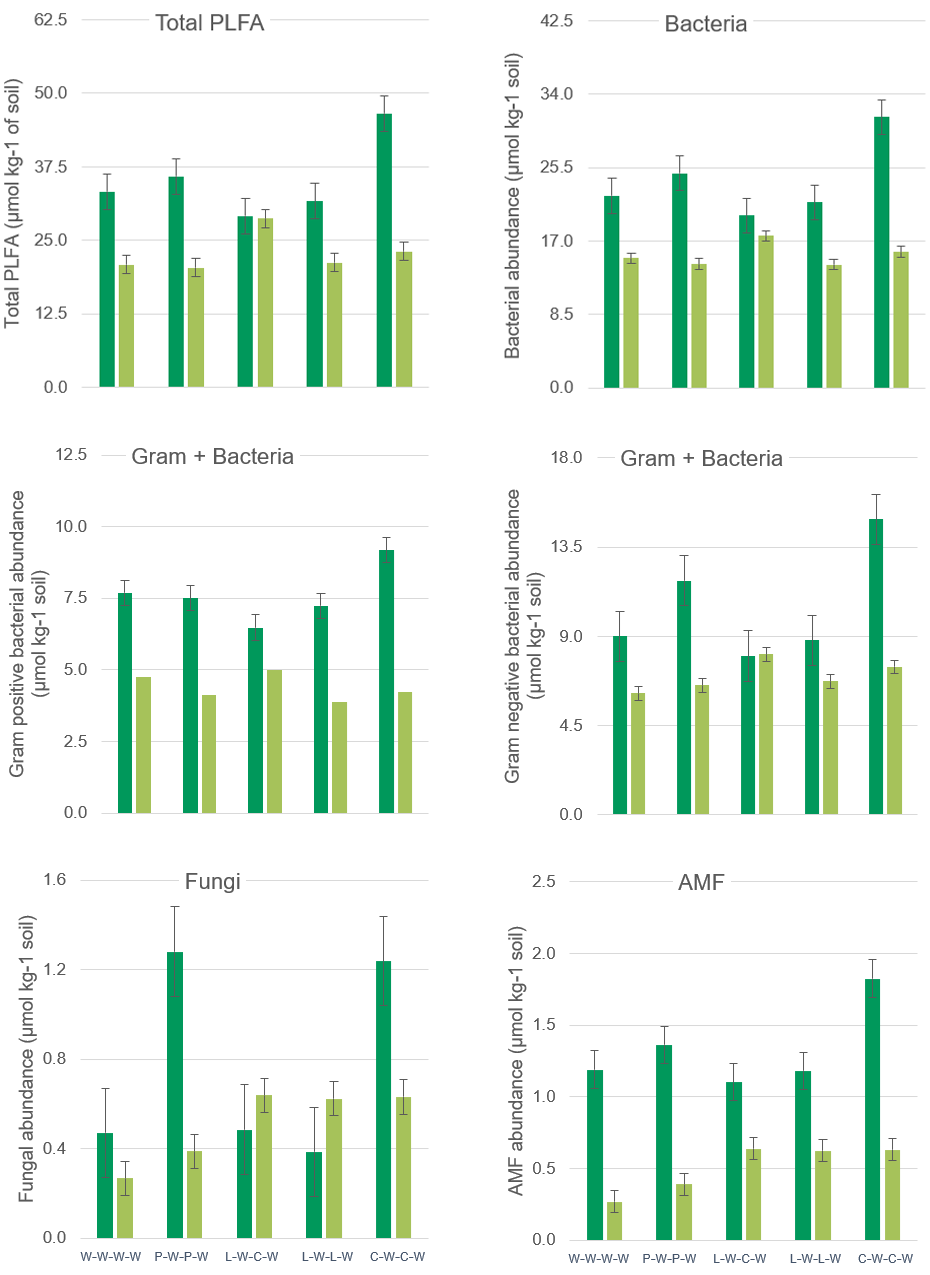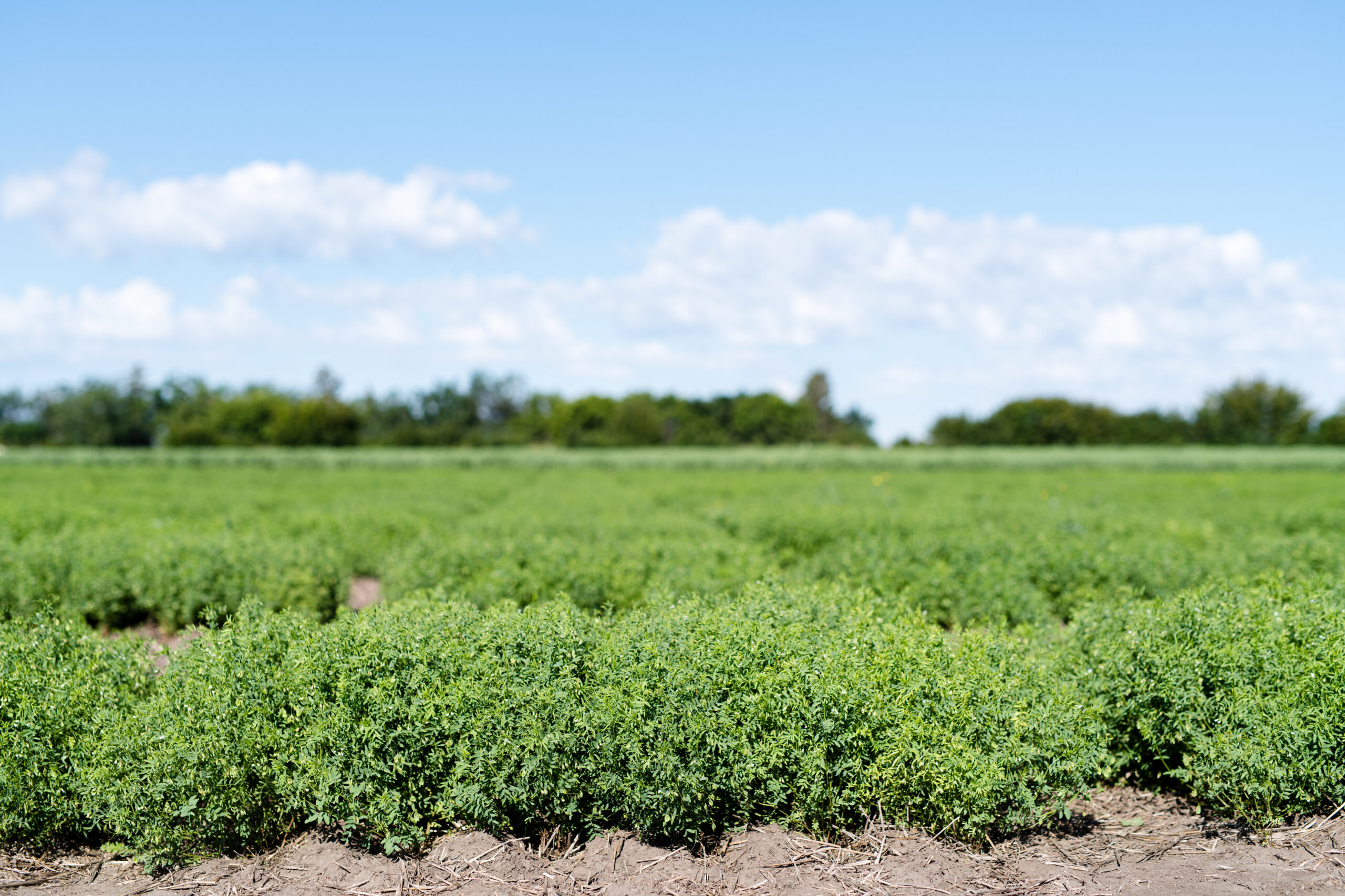This is one of seven research objectives explored under the project “Enhancing the Long-Term Sustainability of Pulse Cultivation Using System Approaches”.
Research collaborators: Dr. J. Diane Knight, Dr. Kui Liu, William May, Dr. Manjula Bandara, Dr. Yantai Gan
Summary prepared by Jennifer Bogdan, PAg, CCA
Background
Pulse crops in the Canadian Prairies have been effectively incorporated into cereal and oilseed rotations, providing benefits such as reduced nitrogen fertilizer usage, improved soil quality, a break- crop for cereal and oilseed disease pathogens, and increased overall crop system productivity. However, some farmers have experienced that intensifying pulse crops in rotations, where a high frequency of pulses are grown in the rotation, may have a negative impact on their overall productivity, such as having more frequent disease issues. Also, there are still unknown effects of pulse intensified rotations on soil carbon, soil nitrogen, soil microbes, and production sustainability. This research objective aims to provide information on the impact of using pulse crops more frequently in rotations on soil structure, soil organic matter, and the soil microbial community.
Key Findings
- Soil carbon (C) and nitrogen (N) were impacted more by the current crop than the overall crop rotation.
- Continuous wheat had higher amounts of soil macro-aggregates, whereas pulse crops had more micro-aggregates, indicating their quicker transformation into the initial steps of decomposition.
- Of the pulse crops, chickpea residue was the most difficult for soil microbes to break down, but over time, there was no difference in the amount of decomposition compared to pea and lentil.
- Including pulse crops in rotations was not sufficient to influence the amount of highly stable organic matter formed in the 8 years of this study.
- Soil microbial populations were influenced more by the year than by the specific crop rotation. Fungal populations favoured pea and chickpea, with arbuscular mycorrhizal fungi (AMF) being the most common fungus in chickpea.
Research Methodology
Soil quality evaluations were performed on four rotations at Swift Current, SK and Brooks, AB: (1) Continuous wheat (W-W-W-W); (2) Pea-wheat every two years (P-W-P-W); (3) Lentil-wheat every two years (L-W-L-W); and, (4) Chickpea-wheat every two years (C-W-C-W). An additional rotation, (5) Pulse-wheat every two years using lentil and chickpea (W-L-W-C) was also evaluated. These rotations were in place for 8 years from 2010–2017. Soil samples were taken in the fall of 2016 (after the 7th year of the rotation and final year of a pulse crop in the rotation, except for the continuous wheat treatment) and in the fall of 2017 (after the eighth year of the rotation and a wheat year) for all treatments. Soil was sampled at three depths (0–10 cm, 10–20 cm, and 20–30 cm) and analyzed for total C and N, inorganic N, organic C, active C, pH, electrical conductivity (EC), bulk density, soil aggregate distribution, water extractable organic matter (WEOM), very light fraction organic matter (VLFOM), light fraction organic matter (LFOM), heavy fraction organic matter (HFOM), cation exchange capacity (CEC), soil microbial C and N, and N mineralization potential. Phospholipid fatty acid (PLFA) analysis was also conducted as part of the microbial population comparisons.
Soil C and N Results
Soil C and N were more impacted by the current crop in the rotation than the overall rotation. Higher amounts of C were present in the top 10 cm and gradually decreased with soil depth as a result of crop residue being added to the soil surface. Crops with lower amounts of biomass produced, as seen in the lentil phase of the rotation, had lower amounts of soil C. Soil N trends largely followed soil C. For example, chickpea in the pulse phase had significantly higher total soil N than any of the other crops and also had the most total soil C (significantly higher than L-W, but not than W-W or P-W). The higher residue inputs from chickpea resulted in the addition of higher amounts of organic N contributing to higher amounts of total N. Organic matter can be a useful indicator of soil quality. All of the pulse crops had similar amounts of inorganic N mineralized by the time the wheat crop was seeded the following spring.
Soil Aggregate Size Results
Soil aggregate size was measured in the top 5 cm of soil in the spring after the wheat year as well as the spring after the pulse year. Macro- aggregates help to protect the soil from erosion (wind, water, tillage). Micro-aggregates represent the first stage of C stabilization in the soil. Continuous wheat showed the highest proportion of macro- aggregates, whereas pulse crop rotations had more micro-aggregates, particularly in the year after the pulse crop was grown (Figure 1). This suggests that pulse crops are better at the initial stage of aggregate formation with the C released from microbial degradation of OM. Although pea and lentil produce less above- and below-ground biomass than chickpea, they still had similar amounts of aggregation as chickpea.

Soil Organic Matter Results
In no-till systems, organic matter (OM) ages with soil depth meaning that more processed OM is deeper in the soil profile. The different degrees of microbial processing make up the different fractions of OM – very light fraction OM (VLFOM) are the newest residue inputs, light fraction OM (LFOM) are intermediate, and heavy fraction OM (HFOM) are the oldest inputs. Minerals, typically clay particles, bind to the HFOM (giving it its ‘heaviness’) and protect the C from microbial breakdown. C:N ratios differ among the OM fractions, with C:N of VLFOM very similar to that of previous standing crops. As microbial breakdown occurs, the C:N decreases since microbes use the C as an energy source. Cereal residues have higher C:N ratios and take longer to mineralize their N (i.e., N immobilization is increased) than pulse crop residues with their low C:N ratios.
The results from this study showed that the OM fractions were generally the same between the final pulse year and the final wheat year, meaning that the rotation did not have a consistent effect on the OM fractions of the soil. The W-W and C-W rotations at Swift Current and the C-W rotation at Brooks had significantly higher amounts of VLFOM and C, and increased N. This was due to wheat and chickpea having larger above-ground and root biomass, and therefore taking longer to break down, than pea and lentil. However, at both locations, these differences became less apparent in the lower OM fractions as more decomposition occurred. In both Swift Current and Brooks, the P-W rotation had the lowest LF-C and N and the highest HF-C and N, suggesting that the pea rotation is breaking down the OM more quickly into its stable form, although this trend was not always statistically significant. However, the overall impact of crop rotation on HFOM was negligible and it was concluded that pulse crop rotations were not able to influence this stable form of OM during this study. Since changes to OM take many years to detect, the eight years in this study may not have been long enough to measure any differences.
Water extractable OM (organic matter in the soil solution that is most easily degraded by microbes) was measured at Swift Current and was found to be not affected by crop rotation.
Soil Microbial Community Results
Microbial populations were impacted by individual years rather than by specific crop rotations. Fungal populations appeared to be higher in pulse rotations compared to continuous wheat, especially in the pea and chickpea rotations (Figure 2). The most common fungus in chickpea was AMF. Furthermore, the C-W rotation generally had the highest amount of soil microbial diversity.
Conclusions
Individual crop years had more of an influence on soil C and N dynamics than the overall crop rotation. Pulse crop rotations tended to have higher fungal populations than continuous wheat. Pea and lentil residue was more easily broken down by soil microbes compared to chickpea and wheat residue initially, but there were no differences in the amount of highly stable HFOM formed between any of the crop rotations. Since the final highly stable stage of OM takes multiple years to form, a study of longer than 8 years may be required to measure any differences in OM formation between crop rotations.

Acknowledgements
This project was funded by Saskatchewan Pulse Growers, the Saskatchewan Ministry of Agriculture – Agricultural Development Fund, and Agriculture and Agri-Food Canada.



